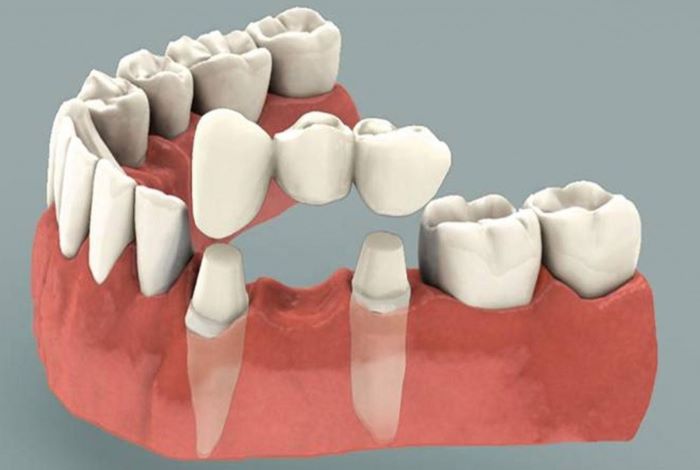All You Need to Know About Dental Bridges

If you have lost a tooth or have missing teeth that were originally adjacent to each other, your dentist may have suggested replacing them with a dental bridge. A dental bridge is designed to bridge the gap left behind by a missing tooth or teeth that were originally side by side. It consists of dental crowns that fit over the teeth adjacent to the gap; these teeth are called abutment teeth.
The replacement tooth or teeth are fitted between and are attached to the crowns to create a complete restoration. Each replacement tooth is called a pontic. Dental bridges are a tried and tested way to replace missing teeth, producing good results in a way that is reasonably non-invasive and quick to complete.
Other Types of Dental Bridges
In addition to a traditional bridge that is supported by teeth on both sides of the gap, two other types of bridges may be suitable for your needs.
One is called a cantilever bridge and is used when you only have suitable adjacent teeth for support on one side of the gap. It’s not commonly used because it tends to put too much strain on the adjacent teeth. A cantilever bridge isn’t suitable for replacing large molars as chewing food would put too much strain on the adjacent or abutment teeth.
A Maryland bridge consists of “wings” made from metal or porcelain and which are bonded onto the inner surfaces of abutment teeth, supporting the pontic. It’s another solution that is used very infrequently and only in specific circumstances. Maryland bridges aren’t very strong and tend to be best used when restoring front teeth. Sometimes they may be a temporary solution, for example, while waiting to have a dental implant fitted.
Why Choose a Dental Bridge?
A dental bridge is an excellent way to restore your smile quite quickly, and it will restore your ability to chew food properly and to speak clearly. As you chew your food using your new dental bridge, the forces created during chewing are more evenly distributed, so there is less chance of excessive wear and tear on your remaining natural teeth.
Materials Used to Create Dental Bridges
Dental bridges can be made from a variety of materials, and traditionally they have a substructure made from precious metal alloy or gold and which can be covered with porcelain, or the metal alloy may be polished to a high sheen. However, over the past few years, more bridges are made from something called zirconia and which is entirely metal-free. Zirconia is a very strong ceramic material that looks and feels fantastic, and bridges made from zirconia can appear amazingly natural. If you do need a bridge, our dentist Dr. Marc McRae can discuss all possible materials and bridge types with you, including the pros and cons and costs of each option.
What Is the Procedure for Having a Dental Bridge?
The procedure for having a dental bridge is very straightforward. Initially, your teeth must be prepared for the bridge. We use a local anesthetic to ensure you feel entirely comfortable and Dr. McRae will carefully reshape the abutment teeth, creating enough room for the dental crowns. It is necessary to remove some material as otherwise, these crowns would look and feel much too bulky. Once Dr. McRae is happy with the preparation, we take a digital dental impression. Digital impressions are newer and much more accurate technology, and they are far more comfortable for our patients! Instead of an uncomfortable mouth tray filled with goopy impression material, your teeth are scanned using a tiny handheld camera that looks a little like a large pen. The camera takes thousands of images that are digitally stitched together to create a 3-D model of your teeth.
Another huge advantage of this technology is that Dr. McRae can check the impression immediately on screen, and if needed, can make small adjustments to your teeth before retaking the scan, ensuring you receive a precision fitted and beautiful restoration. Once he is happy with the digital impression, it is transmitted to the dental lab so they can begin making your dental bridge to his exact prescription. While your bridge is being made, your teeth are protected with a temporary restoration.
On your second visit, the temporary restoration is removed, and your permanent bridge is tried in. Dr. McRae will make sure it fits accurately, and of course, that it looks and feels very natural before the bridge is bonded permanently in place. Initially, any new dental restoration will feel a little strange, but you should quickly become accustomed to your new bridge, and it should feel very comfortable.
How Long Will a Dental Bridge Last?
Your dental bridge should last for years before it eventually needs replacing. It’s not unusual for a bridge to last over ten years with good oral hygiene and regular checkups and cleanings.
Caring for Your Dental Bridge
It is essential to care for your dental bridge properly and to make sure you brush your teeth twice a day and floss once a day. When we fit your bridge, we can show you how to floss underneath the pontic and around the abutment teeth. Maintaining good oral hygiene will help prevent tooth decay and gum disease that can cause tooth loss. Be sure to come and see us regularly for your checkups and professional dental cleanings, so Dr. McRae can check the condition of your bridge, ensuring it still fits tightly around your abutment teeth. Regular hygiene appointments allow us to professionally clean around your dental bridge and your natural teeth, reducing your risk of dental disease and ensuring your smile looks its best.
Implant-Supported Dental Bridge
Although traditionally, dental bridges are supported by natural teeth, they can also be supported by dental implants. An implant-supported bridge can be an excellent solution when you have lost multiple teeth and your remaining teeth aren’t strong enough to act as abutment teeth or are missing entirely. It is even possible to have a large bridge that replaces an entire arch of teeth and is solely supported by dental implants. It’s an extremely popular solution for people who do not wish to have traditional dentures. If you are only missing a single tooth, a single dental implant is an alternative solution to a three-tooth bridge. When treating patients who have lost teeth or who are facing tooth loss, we always discuss all potential solutions, including dental bridges, implants, and dentures.
Are you looking for a Las Vegas dentist who can cover all your dental needs? Contact us at Willow Springs Dental – we are the premier provider of quality Las Vegas dentistry. We’d love to meet with you to see what we can accomplish together!




Please login to publish a comment.
Comments (0)